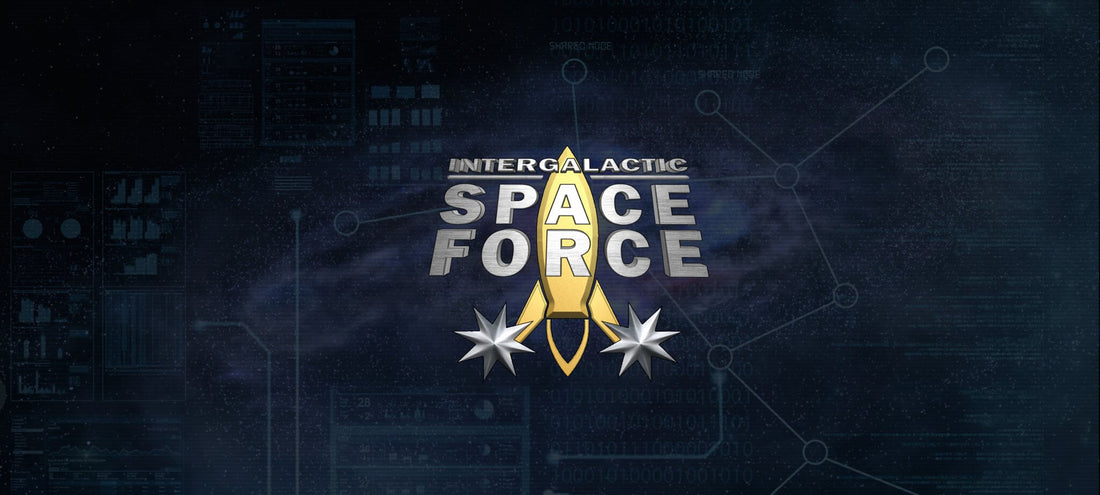
The theory behind the compression drive
Many sci-fi stories have to deal with a real-world issue that flies in the face of real-world physics. That is, you can’t travel faster than the speed of light. Even if you could go at the speed of light, it would still take decades, even centuries, to traverse the galaxy. There are a lot of different fictitious answers to this problem. Star Wars has hyperspace. Star Trek has warp drive. Stargate had . . . well, stargates, these sci-fi portals that link worlds. In Intergalactic Space Force, the in-cannon explanation for faster-than-light travel is the compression drive, and it’s based on real-world theories in physics that say empty space can be compressed.
Can we compress empty space?
The theory of compressed space finds its roots in the profound discoveries of general relativity by Albert Einstein. According to Einstein's theory, space and time are inextricably linked, forming a fabric known as spacetime. It is within this fabric that massive objects create gravitational fields, curving the very fabric of spacetime.
Inspired by the principles of general relativity, physicists and cosmologists began contemplating the idea of manipulating spacetime. They theorized that by compressing space, it might be possible to create shortcuts, wormholes, or even travel between distant regions of the universe faster than the speed of light. These bold notions sparked a new frontier of research and exploration into the potential compression of space.
Real-world issues with compressing space
If the theory of compressed space holds true, its implications for space exploration and the understanding of the cosmos are profound. One of the most intriguing prospects is the possibility of traversable wormholes. These hypothetical tunnels through spacetime could serve as shortcuts between distant points, enabling interstellar travel that defies our current understanding of physics.
Compressed space also raises questions about the nature of time. If space can be compressed, could time itself be manipulated? The idea of time travel, once confined to the realms of science fiction, gains plausibility within the context of compressed space. Although still speculative, the theory opens avenues for exploring the mysteries of the past and the future.
Furthermore, the compression of space has the potential to revolutionize our understanding of the universe's expansion. By compressing space ahead of an object while expanding it behind, we may be able to achieve faster-than-light travel, effectively circumventing the cosmic speed limit. This is basically the warp drive from Star Trek. In the world of Intergalactic Space Force, the idea of compressing space is used a bit differently. The fictitious compression drive acts more like how it’s described in A Wrinkle in Time where the ship flies in normal relative speeds, but the drive compresses the space around it so the distance it must travel is reduced. This has in-cannon complications. In The Cherub Threat, the Cherub home world is in the center of a nebula, which means the space isn’t empty. It’s filled with thick gas clouds, and since gas is made up of physical particles it can only be compressed so much. This becomes an obstacle to our heroes that must overcome.
Despite the intriguing possibilities, the theory of compressed space faces significant challenges and obstacles. The first and foremost hurdle lies in the immense energy requirements for compressing space. The energy densities required to manipulate spacetime on such scales are currently beyond our technological capabilities, making the practical realization of compressed space a distant prospect.
Moreover, the theoretical underpinnings of compressed space are still in their infancy. Much work remains to be done in reconciling the theory with the well-established principles of quantum mechanics. The integration of quantum physics with compressed space is a formidable task that will require groundbreaking advancements in our understanding of both fields.
However, despite these challenges, researchers remain optimistic and motivated to explore this tantalizing avenue. Advancements in theoretical physics, along with technological breakthroughs in energy generation and manipulation, may pave the way for the compression of space to become a tangible reality in the distant future.
The theory of compressed space presents a fascinating concept that pushes the boundaries of our current understanding of the universe. Its implications for space travel, time manipulation, and our perception of reality are awe-inspiring. While many obstacles must be overcome before the compression of space becomes a practical endeavor, the journey of exploration and discovery itself is invaluable. In the meantime, however, we can imagine how such a compression drive would work int eh world of Intergalactic Space Force.
